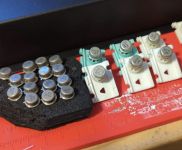Really not possible to answer this any way but "it depends".
What is the forward voltage on the diodes, soft or hard clipping, what kind of op amp, voltage at which the circuit runs, is it a stage that is already boosted by a previous stage, etc.?
If you ever built a Rat or TS with a clipping switch where you can also select "no diodes", you will find that you get clipping with the gain high even without diodes, but you'll have more clean headroom (usually). The way that the op amp clips does contribute to the tone as well especially on high gain settings, which is why LM308 Rats tend to sound more fuzzy and saggy than other op amps (and I know people will disagree with me, but I do in fact have a fancy Rat with an op amp rotary with which I have tested this extensively).
Transistors certainly do clip and you can also have soft and hard clipping in/after transistor stages. Usually transistor clipping sounds "nicer" than op amp clipping, which is why most op amp circuits have diodes to help out with the clipping character. Cascaded JFET/MOSFET circuits like the Plexi Drive or Box of Rock have no diodes, a Big Muff has "soft-clipping" diodes in 2 of its transistor stages and Electras like the EQD Speaker/Special Cranker are basically a transistor driving hard clipping diodes.


